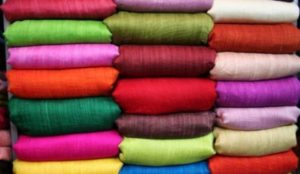 Calico is a linen fabric made from cotton yarn No. 40. This thread number is usually used by housewives for their sewing machines. The word calico itself is of Turkic origin, since it was first produced in Asia from cotton on hand looms. The word beyaz is translated as white from modern Turkish and Azerbaijani languages. In these countries, cotton linen is still produced.
Calico is a linen fabric made from cotton yarn No. 40. This thread number is usually used by housewives for their sewing machines. The word calico itself is of Turkic origin, since it was first produced in Asia from cotton on hand looms. The word beyaz is translated as white from modern Turkish and Azerbaijani languages. In these countries, cotton linen is still produced.
Until the 17th century, calico canvases were brought to Russia by merchants, and they were in demand. Tailors used the material as lining for caftans. With the advent of a regular army in Tsarist Russia, the need for uniforms increased, and cotton linen was used to sew soldiers' linen. Around the same period, enterprising industrialists from Kineshma organized the production of calico in Russia. They correctly calculated that such production would be successful and that investments in the construction of factories would pay off.
When making fabric, 2 frames with healds are installed on the machines, through which the threads pass. Their weaving is simple, in 2 cycles.When one frame goes up, the second goes down, forming a shed in which the weft thread is laid. The frames are swapped, the threads are crossed with the cross thread, and the weft is laid again. Thus, the interlacing of threads occurs, which is called plain. The material looks the same on the front and back sides.
Important: real calico is made from pure 100% cotton, without the addition of synthetic fibers. This technology is still followed in Russia, Azerbaijan and other countries of the former Union.
Indian and Pakistani manufacturers add up to 15 percent synthetic fiber to the composition. There is fabric made in China.
Just a quarter of a century ago, there was only one density - according to GOST - 142 g/m2, and the grade was determined by the presence of defects (defects). But enterprising manufacturers came up with a so-called “budget” option, increasing the distance between the weft (transverse) threads by a few tenths of millimeters. As a result, the density of calico decreased to 105 g/m2. Calico fabric with a density according to GOST shrinks 5-7% during the washing process; less dense “budget” fabrics have a higher percentage of shrinkage, and this must be taken into account when sewing linen or clothes.
If you plan to sew yourself and buy fabric for this, first wash it at a water temperature of forty degrees, dry it, and iron it. During the washing process, the calico will shrink, get rid of the technical smell, and become softer. Now you can consider that she is ready to sew those things that were planned.
Classic calico is a harsh material that has a characteristic yellowish tint. But the interesting thing is that the cotton in the box is snow-white.The warp threads on warping machines are wound onto a large bobbin - a beam, the width of which determines the width of the fabric. During the winding process, the threads are treated with a starch solution.
The fact is that the warp experiences stress on the loom and breaks. Starch treatment reduces the percentage of breakages. The fabric turns out to be somewhat rough and rigid. The starch probably gives the fabric a yellowish tint. In this form it sometimes goes on sale. It is used for rough upholstery of furniture and other technical needs. Calico has commercial widths of 100, 110, 140 cm.
Material not available for sale is further processed by bleaching or dyeing. During these technological processes, starch is removed from the fibers, the material becomes thinner and more noble.
Its qualitative characteristics and properties make it attractive for sewing products that are close to the body. This:
Bleached calico turns out to be perfectly white. Plain-dyed fabric has a varied but uniform color. Both fabrics are used for sewing bed linen - sheets, pillowcases, duvet covers, mattress covers, workwear and others.
Printed fabric, that is, with a printed pattern, is also used for sewing bedding. I also use it to make light, casual clothes.